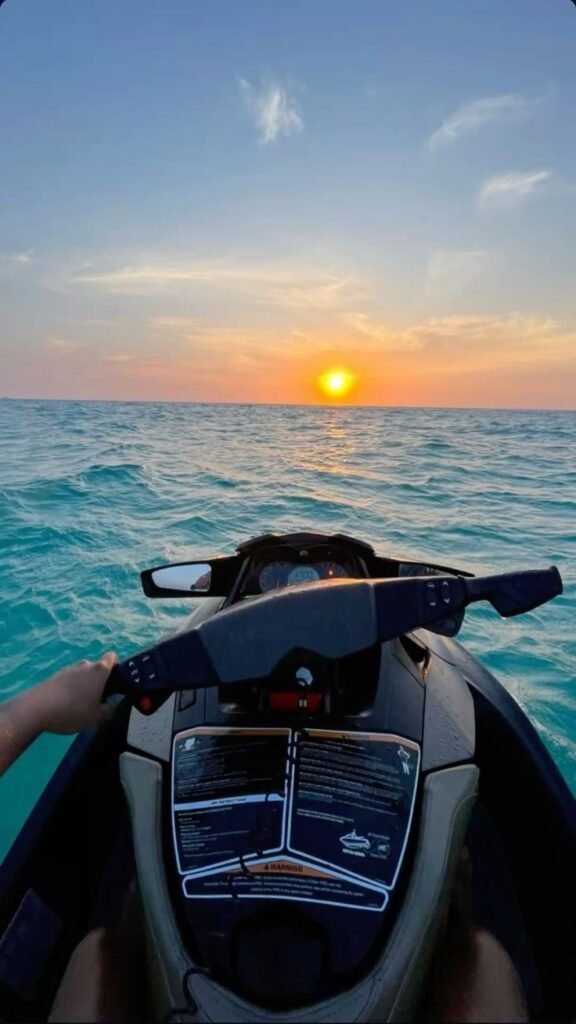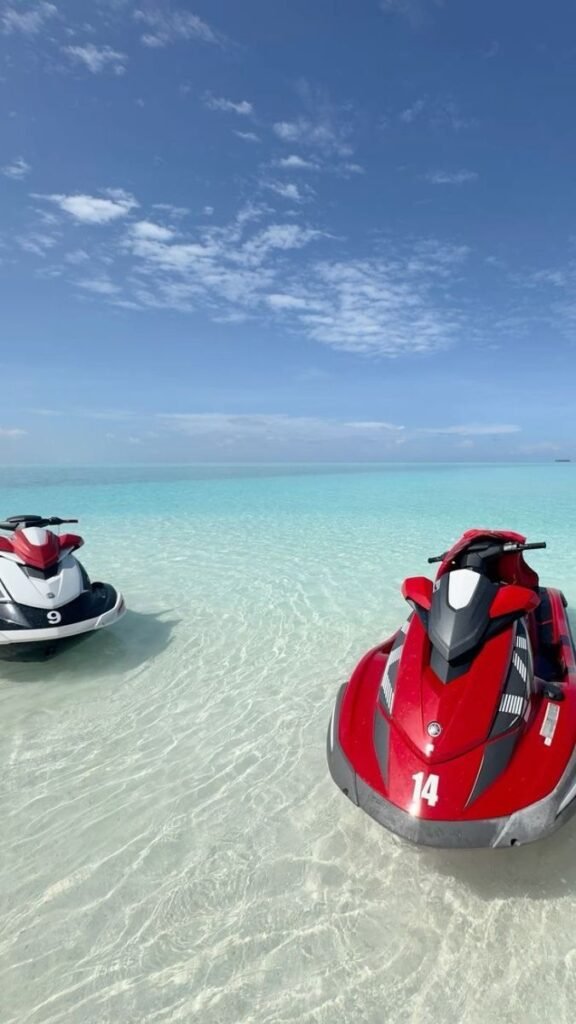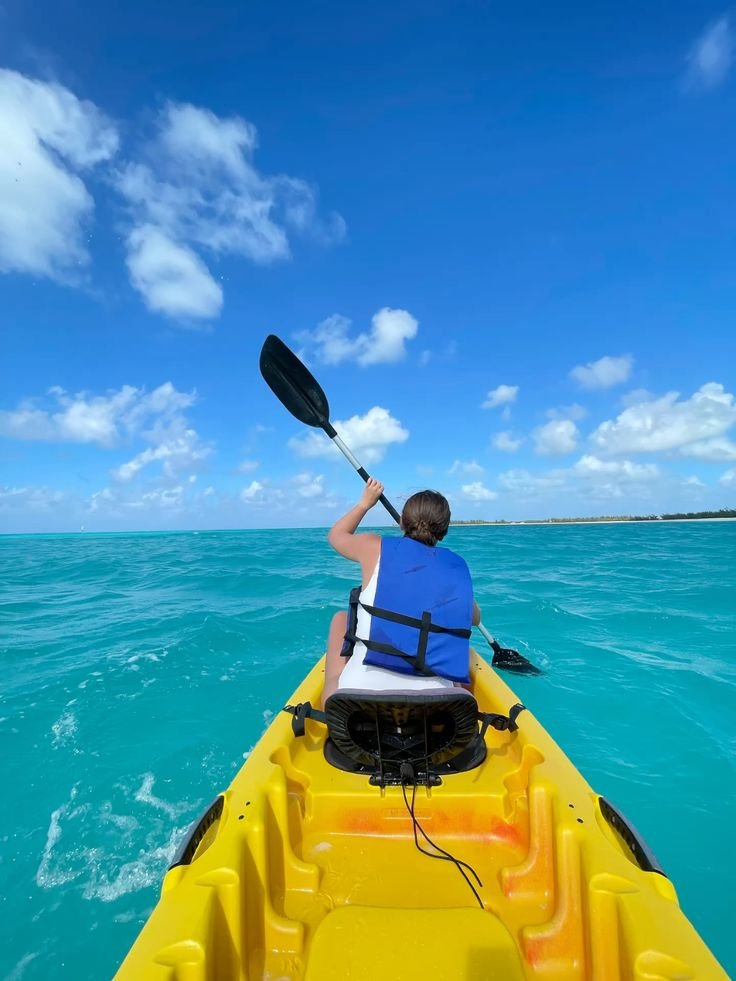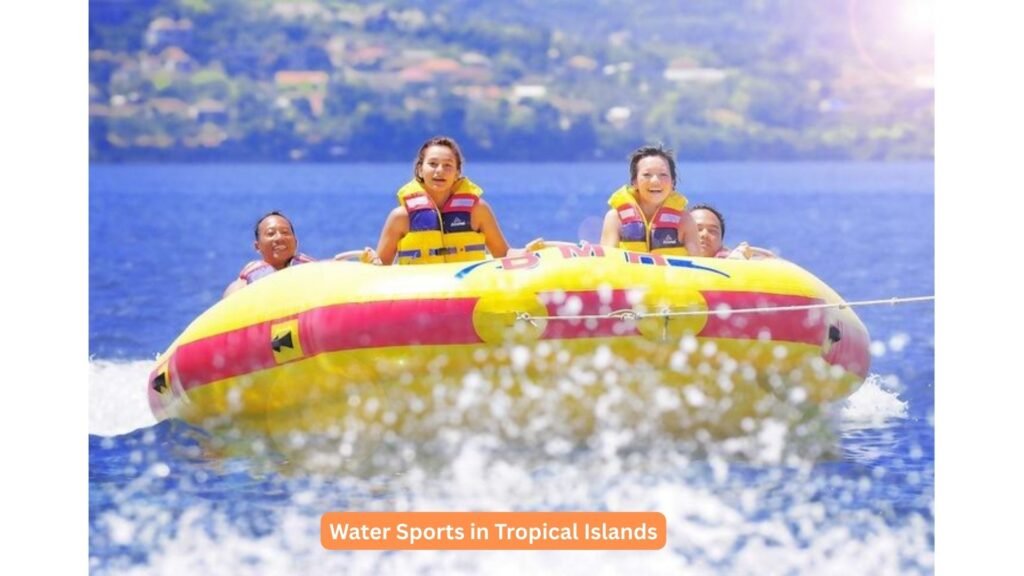Tropical islands represent the perfect playground for water sports enthusiasts, offering a harmonious blend of pristine conditions and breathtaking natural beauty. The combination of warm waters, consistent winds, and vibrant marine ecosystems creates an ideal environment for exploring an impressive range of water sports in tropical islands. Whether you’re seeking peaceful paddleboarding tropical islands experiences or adrenaline-pumping jet skiing island vacation adventures, the best islands for water sports around the world deliver unforgettable island water activities against a backdrop of paradise.
- The crystalline waters surrounding tropical islands provide exceptional visibility for underwater activities, with visibility often exceeding 30 meters in premier destinations like the Maldives, allowing participants to witness spectacular marine life while engaging in surface sports.
- Tropical island microclimates create unique water sport opportunities, where calm lagoons perfect for beginners exist just minutes from challenging reef breaks sought after by experienced enthusiasts.
- Many tropical destinations offer specialized “water sports passes” that provide unlimited access to equipment and instruction across multiple activities, representing exceptional value for travelers looking to experience a variety of aquatic adventures.
- The convergence of traditional island seafaring practices with modern water sports has created distinctive regional styles and techniques, particularly evident in places like Hawaii where ancient outrigger canoe traditions have influenced contemporary paddleboarding approaches.
Top Destinations for Water Sports in Tropical Islands
The world’s tropical belt contains an astonishing variety of islands, each offering distinctive water sports experiences influenced by their geography, climate, and cultural heritage. From the extensive reef systems of the Caribbean to the volcanic formations of the Pacific, these environments create specialized conditions that cater to different water activities and expertise levels, allowing visitors to select destinations that perfectly match their aquatic interests.
- The Hawaiian Islands stand as an unrivaled destination for wave sports enthusiasts, with Maui’s northern shores delivering world-class windsurfing conditions at Ho’okipa Beach during winter months and Oahu’s North Shore presenting legendary surfing breaks like Pipeline and Sunset Beach.
- Thailand’s Andaman Sea islands combine protected kayaking environments with stunning limestone karst formations, particularly around Phang Nga Bay where paddlers can explore hidden lagoons and sea caves only accessible during specific tide conditions.
- The Maldives offers water sports enthusiasts exclusive atoll experiences where luxury resorts feature dedicated water sports centers with professional instruction and cutting-edge equipment, creating perfect environments for beginners to experience activities like underwater sea scooters and transparent kayaks over vibrant coral gardens.
- Australia’s Whitsunday Islands create a sailing paradise with their 74-island archipelago configuration that allows for protected cruising while offering access to parts of the Great Barrier Reef, attracting both day-sailors and multi-day charter enthusiasts seeking biodiversity encounters.
Island Kayaking Tours: Exploring Tropical Ecosystems
Kayaking represents one of the most immersive ways to experience tropical island environments, offering silent propulsion that allows paddlers to approach marine wildlife without disturbance while accessing secluded beaches and coves inaccessible to larger watercraft. The intimate nature of this activity creates unparalleled opportunities to connect with the natural rhythms of island ecosystems while enjoying physical activity suitable for various fitness levels.
- Palawan in the Philippines offers kayakers extraordinary bioluminescent paddling experiences in electric-blue waters, particularly in the lagoons near El Nido where nighttime excursions reveal glowing plankton that illuminate with each paddle stroke, creating an almost mystical aquatic experience.
- The mangrove channels of Florida’s Keys provide technical kayaking routes through tunnel-like passages where paddlers can observe unique transitional ecosystems hosting juvenile reef fish, nesting birds, and occasionally manatees seeking the protected waterways during winter months.
- Guided kayak tours in Bora Bora combine cultural interpretation with paddling as local guides share traditional Polynesian navigation techniques while leading small groups across the island’s famous blue lagoon, often culminating with fresh coconut refreshments on private motus (small islands).
- Puerto Rico’s bioluminescent bays, particularly Mosquito Bay on Vieques Island, offer kayakers the rare opportunity to paddle through waters containing microorganisms that produce brief blue-green flashes when disturbed, creating one of the world’s most magical nighttime paddling experiences.
Paddleboarding Tropical Islands: The Ultimate Versatile Water Sport
Stand-up paddleboarding (SUP) has emerged as one of the most accessible and versatile water sports in tropical destinations, providing a unique vantage point from which to observe marine life while traversing island coastlines. The activity’s adaptability makes it appropriate for flat-water cruising, fitness workouts, wave riding, and even yoga practice, establishing SUP as an ideal entry point for water sports newcomers while offering plenty of progression for enthusiasts.
- The protected bays of the Virgin Islands National Park in St. John provide ideal paddleboarding conditions for beginners with their consistently calm waters and abundant sea turtle populations, creating memorable wildlife encounters visible from the elevated standing position.
- Fiji’s Yasawa Islands offer specialized SUP safari experiences where participants paddle between islands over several days, combining the adventure with overnight stays in traditional villages and opportunities to experience authentic kava ceremonies with local communities.
- Advanced paddleboarders seek out the gentle waves of Namotu Island near Fiji’s Cloudbreak for SUP surfing, where the consistent breaks provide an ideal learning environment for transitioning from flat-water paddling to wave riding in warm, forgiving conditions.
- Morning SUP yoga classes have become signature experiences at tropical resorts throughout Indonesia’s Gili Islands, where instructors lead sessions on anchored boards as the sunrise illuminates Mount Rinjani in the distance, creating a perfect harmony of physical practice and natural beauty.
Island Water Activities: Sailing and Boating Adventures
Sailing represents the quintessential tropical island water activity, connecting modern enthusiasts with centuries of maritime tradition while providing access to multiple destinations in a single journey. Whether participating in a short sunset cruise or embarking on a week-long island-hopping adventure, sailing experiences offer an incomparable sense of freedom and discovery that embodies the essence of tropical exploration.
- The British Virgin Islands feature consistent trade winds and close proximity between islands, creating ideal conditions for sailors of all experience levels with options ranging from crewed luxury catamarans to bareboat charters for qualified skippers seeking independence.
- Traditional sailing experiences remain accessible in the South Pacific where vessels like Tahiti’s grand outrigger sailing canoes (va’a motu) offer cultural sailing excursions, allowing visitors to experience ancient navigation techniques used by Polynesian voyagers for centuries.
- The protected coves of Antigua provide perfect learning environments for sailing beginners, with the island hosting numerous sailing schools that offer accelerated certification programs coinciding with the annual Sailing Week regatta when enthusiasts can observe world-class competition.
- Island-hopping catamaran tours in Greece’s Cyclades combine sailing adventure with cultural exploration as vessels navigate between iconic destinations like Santorini and Mykonos, allowing participants to experience the striking contrast between turquoise waters and the islands’ distinctive white architecture.

Water Adventures in Islands: Thrills for Adrenaline Seekers
For those seeking heightened excitement, tropical islands offer a diverse array of high-energy water sports that capitalize on natural elements like wind and waves. These activities deliver powerful sensations of speed, flight, and dynamic movement while showcasing the strength and beauty of tropical environments, providing experiences that remain vivid in memory long after returning home.
- Kiteboarding has transformed previously overlooked destinations like Tarifa in Spain and Cabarete in the Dominican Republic into international water sports hubs where consistent wind patterns create perfect conditions for both beginners and experienced riders hoping to achieve spectacular jumps and transitions.
- Jet ski safari experiences in the Bahamas allow participants to cover substantial distances between islands on guided excursions that combine the thrill of personal watercraft operation with opportunities to visit remote beaches, historic sites, and swimming locations accessible only by water.
- Cable wakeboarding parks have emerged as popular attractions in destinations like Phuket, Thailand, where sustainable facilities use overhead cable systems rather than boats to pull riders, creating consistent training environments for aerial maneuvers and progression.
- Flyboarding experiences in Bali combine water propulsion technology with human balance to create the sensation of superhuman flight, with water jets attached to participants’ feet propelling them up to 15 meters above the water’s surface for an experience that merges adrenaline with breathtaking aerial views.
Best Islands for Water Sports: Underwater Exploration
The extraordinary diversity of marine ecosystems surrounding tropical islands creates compelling underwater landscapes that draw snorkelers and divers from around the world. These subsurface activities allow participants to temporarily enter an alien world of vibrant coral formations, curious fish populations, and complex ecological relationships, providing perspectives impossible to gain from land or watercraft.
- The Raja Ampat archipelago in Indonesia represents the pinnacle of marine biodiversity with over 1,500 fish species and 75% of the world’s known coral species concentrated in this remote region, offering divers unprecedented variety during every underwater excursion.
- The protected marine sanctuary of Bonaire features shore diving opportunities directly from beaches or dedicated platforms, eliminating the need for boat transportation and allowing divers unprecedented independence to explore over 60 marked sites at their own pace.
- Specialized night snorkeling experiences in the Maldives utilize UV lights that cause certain corals, anemones, and fish to fluoresce in electric blues, greens, and reds, revealing a completely different underwater aesthetic impossible to witness during daylight hours.
- The cenotes of Mexico’s Yucatan Peninsula offer snorkelers and divers the extraordinary opportunity to explore freshwater cave systems where crystal-clear waters flow through ancient limestone formations, creating otherworldly light effects as sunbeams penetrate openings in the cave ceilings.
Island Water Activities: Family-Friendly Options for All Ages
Tropical islands excel at providing water-based activities suitable for multi-generational enjoyment, combining safety with excitement to create memories shared across age groups. These experiences often incorporate educational elements alongside recreation, allowing families to connect with marine environments while learning about conservation and ecological relationships in engaging formats.
- Glass-bottom boat tours in destinations like Mauritius combine the comfort and stability of vessel-based exploration with transparent viewing panels that allow passengers of all ages and swimming abilities to observe coral reefs and marine life without entering the water.
- Guided “snorkeling safaris” in the protected lagoons of Bora Bora utilize specially designed flotation devices and shallow, current-free environments to introduce children to underwater exploration under close supervision from experienced guides familiar with handling young participants.
- Dolphin observation programs in Honduras’ Bay Islands emphasize responsible wildlife interaction through naturalist-led excursions where families learn about dolphin communication and behavior while observing these intelligent marine mammals in their natural habitat rather than captive environments.
- Interactive touch tanks at marine education centers throughout Caribbean destinations allow children direct contact with harmless marine creatures like sea stars and non-pinching crabs, creating tactile learning experiences that foster appreciation for ocean ecosystems.

Essential Equipment for Water Sports in Tropical Islands
Successfully enjoying water sports in tropical environments requires appropriate equipment selections that address the unique challenges of warm-water activities while maximizing comfort and performance. Understanding the specialized gear available for different conditions helps participants focus on enjoyment rather than discomfort, with equipment considerations varying significantly between different activities and experience levels.
- UV-protective rashguards have evolved beyond simple sun protection to incorporate cooling technologies that actively reduce body temperature during tropical water activities, with advanced fabrics that dry quickly between sessions and provide defense against both harmful rays and occasional contact with marine organisms.
- Purpose-designed tropical wetsuits utilize ultra-thin neoprene (typically 0.5-1mm thickness) to provide minimal thermal insulation while delivering protection from reef abrasions and sun exposure, incorporating strategic ventilation zones that prevent overheating during extended water sessions.
- Climate-appropriate water sport footwear addresses specific tropical hazards including sharp coral, hidden sea urchins, and hot sand with specialized designs ranging from neoprene reef booties with puncture-resistant soles to quick-draining water shoes that transition effectively between land and sea.
- Miniaturized personal safety equipment including GPS-enabled location devices, compact emergency strobe lights, and lightweight marine VHF radios provide crucial security margins for tropical water sport enthusiasts venturing beyond supervised areas, with models specifically designed to withstand saltwater immersion.
Safety Considerations for Water Sports in Tropical Islands
The apparent paradise of tropical environments can conceal various hazards that require awareness and preparation, from powerful oceanic currents to weather patterns that can change rapidly. Understanding the safety measures appropriate for different island water sports creates a foundation of security that allows participants to embrace adventure with confidence while minimizing unnecessary risks.
- Marine weather applications specifically designed for water sports participants provide hyperlocal forecasting focused on wind, tide, and wave conditions essential for activity planning, with some advanced platforms incorporating crowdsourced reports from other users already on location.
- Understanding geographical indicators of rip currents, including breaks in incoming wave patterns and visible water color differences, allows participants to identify and avoid these powerful outflows that account for the majority of ocean rescues in tropical destinations.
- Proper hydration protocols become critically important during tropical water activities as participants often fail to recognize fluid loss while surrounded by water, with experts recommending consumption of electrolyte-enhanced beverages before, during, and after sessions regardless of thirst sensation.
- International dive and water safety organizations have developed universal hand signals adapted for different water sports that allow effective communication between participants and instructors even across language barriers, providing standardized methods to indicate distress or assistance needs.
Cultural Connections: Traditional Water Practices in Tropical Islands
The rich maritime heritage of island communities has created distinctive water traditions that continue to influence contemporary water sports, offering visitors opportunities to experience authentic cultural practices that have evolved over centuries of human relationship with the sea. These traditional activities provide deeper connections to destination communities while showcasing indigenous knowledge and skills refined through generations.
- Hawaiian outrigger canoe paddling experiences connect participants with the ancient Polynesian voyaging tradition that populated the remote Pacific islands, with community clubs throughout the islands offering cultural programs that combine physical activity with oral histories and traditional protocols.
- The generations-old practice of free diving continues in Japan’s Okinawa islands where female Ama divers harvest seafood without breathing apparatus, with several coastal communities now offering educational programs where visitors can learn about their traditional techniques and spiritual relationship with the ocean.
- Traditional fishing experiences in the Maldives demonstrate sustainable practices refined over centuries of atoll life, with excursions led by local practitioners who share knowledge about reading water conditions, understanding fish behavior, and utilizing low-impact harvesting methods adapted to fragile reef ecosystems.
- The ancient maritime cultural landscape of Indonesia’s Bajau sea nomads provides glimpses into a lifestyle fully adapted to water environments, with community-based tourism initiatives now offering respectful opportunities to observe their remarkable freediving abilities and traditional boat-building techniques.

Planning Your Perfect Jet Skiing Island Vacation
Creating a successful water sports-focused island vacation requires thoughtful consideration of factors including seasonal conditions, skill development opportunities, and equipment logistics. Strategic planning enables visitors to maximize their aquatic experiences while accommodating various interests and abilities within travel groups, resulting in customized adventures that deliver optimal enjoyment.
- Consider scheduling island visits during “shoulder seasons” when water conditions remain favorable but visitor numbers decrease substantially, creating experiences with reduced crowds and often significantly lower prices for both accommodations and water sport instruction.
- Research specialized water sports events that coincide with your travel dates, as many islands host competitions, festivals, and exhibitions that provide opportunities to observe elite performers, test next-season equipment, and participate in clinics led by world-class athletes and instructors.
- Evaluate island destinations based on their “water sports radius”—the diversity of activities accessible within a reasonable travel distance—with the most versatile locations offering protected bays, open ocean conditions, and specialized environments like mangroves or reef systems all within easy reach.
- When traveling with mixed experience levels, prioritize destinations featuring “progression environments” where beginners, intermediates, and advanced participants can simultaneously enjoy appropriate challenges in close proximity, allowing group members to share the overall experience while engaging at individual comfort levels.
Sustainable Approaches to Water Sports in Tropical Islands
The fragile nature of tropical marine ecosystems demands responsible practices from water sports enthusiasts hoping to preserve these environments for future generations. Adopting sustainable approaches to equipment selection, operator choice, and personal behavior allows participants to minimize their environmental impact while actively contributing to conservation efforts through engagement with marine stewardship initiatives.
- Support water sports operations that have achieved recognized sustainability certifications such as Green Globe or Blue Flag designations, indicating adherence to internationally established environmental standards for equipment maintenance, waste management, and wildlife interaction protocols.
- Participate in “adventure philanthropy” programs where water sports operators dedicate specific tours or a percentage of proceeds to local marine conservation projects, creating experiences that combine recreation with direct support for environmental initiatives like reef restoration or habitat protection.
- Choose reef-safe sunscreen products specifically formulated without oxybenzone and octinoxate—chemicals proven harmful to coral health—instead selecting mineral-based alternatives containing non-nano zinc oxide or titanium dioxide that provide effective protection without ecosystem damage.
- Engage with citizen science opportunities integrated into recreational activities, including coral monitoring programs where snorkelers and divers collect observational data valuable to research organizations tracking ecosystem health across tropical marine environments.
By embracing the extraordinary diversity of water sports in tropical islands, travelers gain access to transformative experiences that combine physical activity, natural beauty, and cultural connection. Whether seeking peaceful island kayaking tours or adrenaline-charged jet skiing island vacations, the warm waters surrounding these paradisical destinations offer perfect conditions for water adventures in islands across every interest and skill level. The best islands for water sports await your discovery, offering paddleboarding tropical islands experiences and countless other island water activities that will create memories to last a lifetime.

